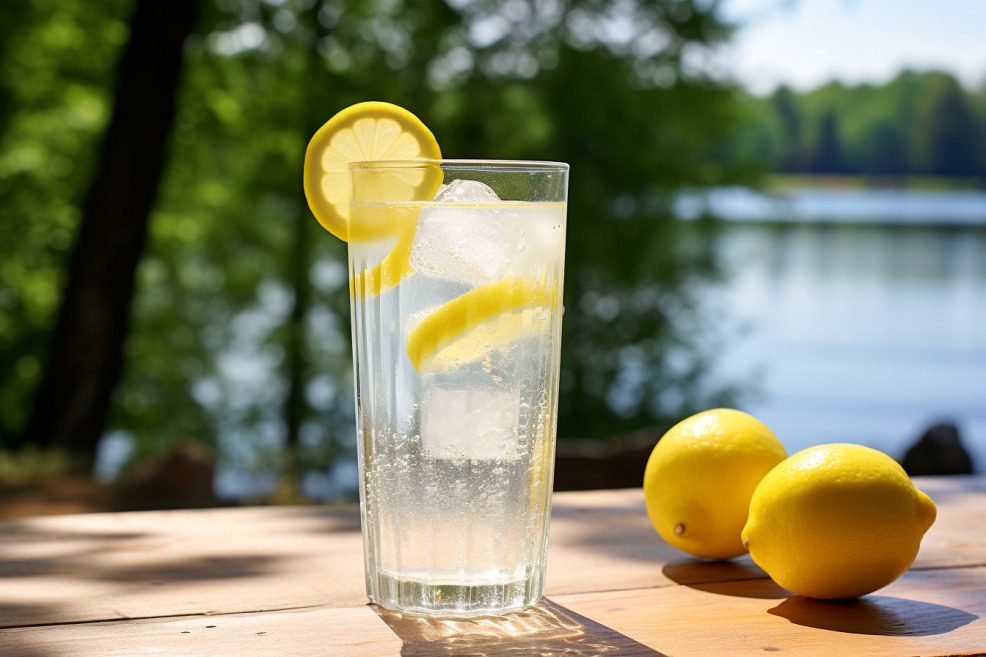The original, inexpensive, quick, easy to make, easy to drink, naturally fermented, lemon, hot-weather, thirst quencher.
Skeeter Pee
Skeeter Pee is a refreshing, naturally fermented lemon beverage that’s perfect for hot weather. It’s quick and inexpensive to make, and even easier to drink. This recipe yields a 5-gallon batch, perfect for parties or for keeping in the fridge for a daily refreshment.
Ingredients
- 3 bottles of 32 oz 100% lemon juice (e.g ReaLemon in the green plastic bottles or equivalent)
- 7 lbs sugar (or 16 cups) to ferment
- 3/4 tsp tannin
- 6 tsp yeast nutrient (3 now, 3 later)
- 2 tsp yeast energizer (1 now, 1 later)
- Approx, 4 1/2 gallons water
- Yeast Slurry
- Potassium metabisulfite (Kmeta)
- Potassium sorbate (sorbate)
- Sparkolloid
- 2 1/3 lbs sugar (or 6 cups) to sweeten finished Skeeter Pee. Use more or less for your tastes.
Directions
- Make invert sugar by adding your 16 cups sugar to a large stainless cooking pot along with 8 cups water and 1/3 cup lemon juice. Stir sugar to dissolve and heat to just below boiling while stirring. Hold at this temperature for about 30 minutes. Allow to cool slightly and pour it into your primary along with 2 of the bottles of the lemon juice (reserve the last bottle until later), and enough additional water to make 5 1/2 gallons. Add the tannin, 3 tsp. of the yeast nutrient and 1 tsp. of the yeast energizer. Stir.
- Test S.G with hydrometer and record. I shoot for an SG of around 1.070 which yields a beverage of around 10% alcohol if it ferments dry. If your SG is a little low, you can add granular sugar to bring it to the target level. Make sure you stir thoroughly to dissolve the sugar; if you have undissolved sugar at the bottom, it will throw off your readings and your Skeeter Pee won’t turn out properly. Vigorously beat the mixture with a wire whip for a couple of minutes to introduce oxygen and purge it of artificial preservatives. I then cover the bucket with a dish towel and let the sit for 24 to 48 hours.
- After 24-48 hours, give it another quick whip and then pour in yeast slurry from the first rack of another batch of wine. It sometimes takes a while, but you should have active fermentation within a couple of days. It helps to keep this must warm (70-78 degrees). You may need to occasionally whip in some additional oxygen with the whip if fermentation seems to be progressing slowly.
- Periodically check the gravity. When it gets down to around 1.050, add the other 3 tsp of nutrient the second tsp of energizer, and the last bottle of lemon juice; vigorously mix it in. Don’t be afraid to introduce some oxygen to the mix at the same time. This late addition of yeast food and oxygen helps reduce the likelihood of your batch developing a sulfur-dioxide problem. (Because of the high acidity and low nutrition, lemon has a higher propensity to developing the sulfur-dioxide rotten egg smell.) After a couple of days, you can rack into a clean, sanitized carboy.
- Allow the Pee to ferment dry and for fermentation to stop (SG between 0.998 and 0.995). Rack into a clean, sanitized carboy. Give the batch a quick degas (use agitation and vacuum if you have the equipment). Add 1/2 tsp Kmeta, 2 1/2 tsp sorbate, and Sparkolliod (follow directions on the package). After two weeks, the Skeeter Pee should be crystal clear. Rack into a clean, sanitized carboy, add 6 cups sugar, and stir to dissolve. Wait two weeks to be sure no new fermentation begins and bottle.
This beverage will often take on slight flavor characteristics of the wine that donates the yeast slurry, keep this in mind when deciding which flavors will blend well with lemon.
- This beverage will often take on slight flavor characteristics of the wine that donates the yeast slurry, keep this in mind when deciding which flavors will blend well with lemon.
- You want to use a healthy yeast slurry to start your batch. If the slurry is coming from wine that is being pushed to high alcohol levels, it’s possible the slurry is suffering from the effects of alcohol poisoning. Therefore, it’s best if the slurry is used while it is still part of an active ferment.
- You may have noticed that you start with 5 ? gallons of must and this is a recipe for 5 gallons. This is because you’ll be leaving a bit more sediment behind at your first racking. Remember that you’re adding the slurry from a previous batch and it will be left behind along with the sediment created by the Skeeter Pee.
- If you aren’t in a hurry, Skeeter Pee will often fall clear without the Sparkolloid (as long as you’ve done a good job of degassing). My batches often clear in 30 to 45 days without fining.
- There’s no need to age this beverage. It tastes great soon after bottling. Serve chilled.

